WHAT ARE HARDWOODS ? Sometimes called broad-leaf trees. Lose their leaves seasonally, in winter. Hardwoods tend to be harder than softwoods (with the exception of Balsa Wood). They have a wider variety of colour and texture than softwoods. Hard woods tend to be more expensive than softwoods and take longer to mature. 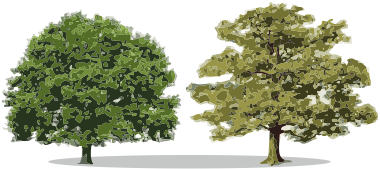 | HARDWOODS 1 EUROPEAN OAK Light tan in colour and straight grained. High quality timber. Moderately hard to work with handtools. Tools should be kept sharp. Produces a high quality finish with wax, furniture oil and varnish. Uses include; quality furniture, cabinet making and boat building. 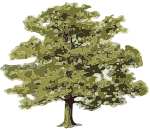 | |
HARDWOODS 2 EUROPEAN WALNUT Grey to brown colour with relatively straight grain. Excellent timber. Tough and can be worked reasonably easily with hand tools. Easy to carve and can be smoothed to a highly polished finish. Used in solid and veneer form for high-class furniture, cabinet making, bank and office fittings. 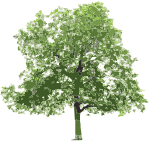 | HARDWOODS 3 BALSA Unlike most hardwoods. Fast growing. Reaches maturity in just five to seven years. Very soft and easy to work with tools. Pale in colour and extremely light to carry/transport. Extremely popular as a material for model making. Also used occasionally to package delicate items. 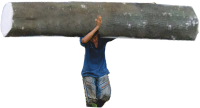 | |
| HARDWOODS 4 EUROPEAN ASH Colour - cream to pale tan. Tough, flexible and straight grained, very good steam bending qualities. Can be shaped and formed well with handtools. A smooth finish can be achieved and stains well. Used for cabinet making, boats and handles of tools. Ash veneered plywood is popular. 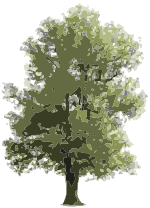 | HARDWOODS 5 BRAZILIAN MAHOGANY Medium to dark brown in colour. Relatively easy to work with hand tools and machinery. Produces a good quality finish with glass paper. Takes varnish well. Wide range of uses including furniture and boat building. Used widely as veneer. 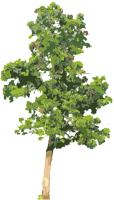 | |
HARDWOODS 6 ENGLISH ELM Light brown / pale brown in colour. Can be difficult to work with handtools, due to awkward grain. Can be worked to a fine finish. Looks particularly good with a waxed finish. Used in cabinet making, turns quite well and is used as veneer, to provide a quality finish on cheaper woods. 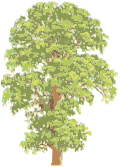 | HARDWOODS 7 EUROPEAN BEECH Pale white to pink brown in colour. Very good for steam bending. It can be worked reasonably well with handtools and machinery. Used for quality furniture, handles, manufacturing chairs and good for wood turning. Often used as a facing for plywood. | |
| WHAT ARE SOFTWOODS ? Softwoods are from trees that have needles / exposed seeds, not leaves. They grow quickly, compared to most hardwoods. When sawn and planed they tend to be light/pale in colour. Softwoods also tend to be cheaper than hardwoods. Softwoods are used by the construction industry and are use to produce paper pulp, and card products. 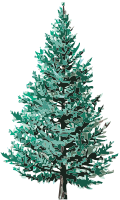 | SOFTWOODS 1 - PARANA PINEVirtually knot free with straight grain, making it ideal for a range of uses. Light brown. Very easy to cut and shape, meaning accurate work is easier to achieve than with most softwoods and hardwoods. A smooth finish can be achieved. Used in the manufacture of furniture. Often used for turning wood products. Used to manufacture plywood. 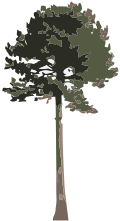 | |
SOFTWOODS 2 - SCOTS PINE Sometimes called Red Deal. A popular natural wood. Can be resinous and have plenty of knots. Coloured from light yellow to dark brown. Can be shaped and formed reasonably easily by handtools and machines. Often used for furniture and the construction industry. Used for interior work. One of the most commonly used woods. 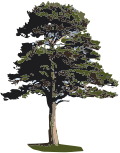 | SOFTWOODS 3 - RED CEDAR Has a pleasant aroma, when cut and machined. Its straight grain means that it works well with tools and machines. Starts as reddish brown in colour, after weathering turns to a silver grey. Used for decking, furniture and general construction. Used for roof shingles, due to its resistance to all weathers. 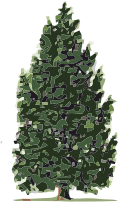 | |
SOFTWOODS 4 - YEW Straight grained which means it can be shaped and formed quite easily. However, the grain can sometimes be difficult to work. An oily wood that resists natural degradation from the weather and elements.. Used to manufacture both interior and exterior furniture e.g. chairs, gate posts and wood turning. 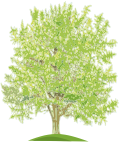 | SOFTWOODS 5 - DOUGLAS FIR A reddish brown wood and relatively knot free. Good to work with handtools and machinery. When smoothed to a fine finish, the grain tends to standout from the surface. Used extensively in the construction industry and in the production of plywood. Also used in a range of joinery work. 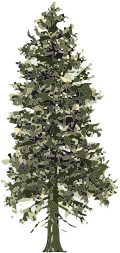 | |
SOFTWOODS 6 - SEQUOIA A reddish to brown wood with a texture that varies from smooth to coarse. Can be worked quite easily with handtools and machines. Glass paper produces a good, smooth finish. Used regularly as roof shingles, due to its resistance to the weather. Used for interior and exterior joinery.  | SOFTWOODS 7 - LARCHHigh in resin and straight grained. Pale red to brick red. Can be worked reasonably well with handtools, if knots are avoided. It is a tough softwood and has a range of uses including; boat planking, window frames, floors and staircases. 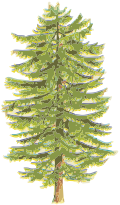 | |
| HAT ARE THERMOSETTING PLASTICS ? Once heated and moulded, these plastics cannot be reheated and remoulded. The molecules of these plastics are cross linked in three dimensions and this is why they cannot be reshaped or recycled. The bond between the molecules is very strong. 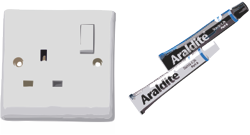 | THERMOSETTING PLASTICS 1 Many adhesives (glues) are thermosetting plastics. For example, Araldite. Composed of two tubes (one is resin, the other a catalyst). They are mixed to form the glue. 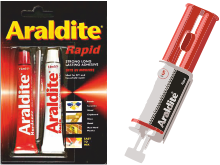 | |
THERMOSETTING PLASTICS 2 Polyurethane. This forms the basis of many paints and varnishes. Tough, water resistant. 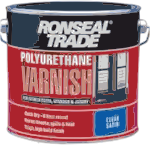 | THERMOSETTING PLASTICS 3 Melamine Formaldehyde. Because of its smooth surface and hygienic qualities, used for kitchen laminates surfaces. Also used for electrical plugs and sockets, because it can be cast and it is an excellent insulator. 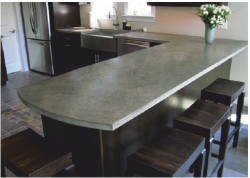 | |
THERMOSETTING PLASTICS 4 Urea Formaldehyde has physical properties of high hardness and high toughness, making it suitable for strong, knock-resistant electrical fittings. It is also scratch resistant and a very good electrical insulator. Electrical fittings manufactured from this polymer are safe to use. 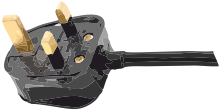 | THERMOSETTING PLASTICS 5 Polyester resins. If resins are combined with a material such as fibre glass, the result is a very tough material that can resist impact. Known as Glass Reinforced Plastic (GRP) and is used in car body repairs, sailing boats and corrugated sheet, because of its lightness, toughness and resistance to water. 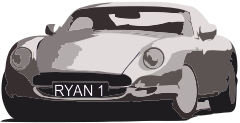 | |
THE DIFFERENCE BETWEEN THERMOSETTING PLASTICS AND THERMOPLASTICSThermosetting plastics once heated and formed to a shape,cannot be reheated and reformed. Consequently, they tend to be difficult to recycle. Thermoplastics once heated and formed to a shape, can be reheated and reshaped. Every time they are reshaped, the quality of the thermoplastic tends to be reduced. They are recyclable. | ||
| HAT ARE THERMOPLASTICS ? These plastics can be re-heated and re-shaped in various ways. They become mouldable after reheating as they do not undergo significant chemical change. Reheating and shaping can be repeated. The bond between the molecules is weak and becomes weaker when reheated, allowing reshaping. These types of plastics can be recycled. 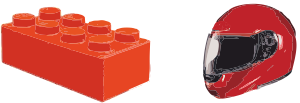 | THERMOPLASTICS 1 Acrylic. (Known also as PERSPEX) This is the most common plastic in a school workshop. Purchased in the form of sheets and comes in a range of colours. It can be translucent (e.g. smoked), transparent or opaque. It is resistant to most acids and weather conditions. Easy to cut shape. Polishes well. Baths, safety glasses, signs. 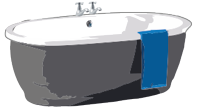 | |
THERMOPLASTICS 2 LDPE - Low Density Polythene is tough and flexible. Softer than HDPE. Can be moulded into almost any form. Flexible, comes in range of colours. Bottles and plastic bags are made from the low density polystyrene. 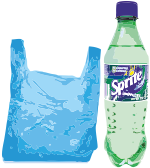 | THERMOPLASTICS 3 HDPE - High Density Polythene which is rigid and hard. Less flexible than LDPE. Machine parts, bowls and crates are generally made from high density polystyrene. Can be moulded into almost any form. Flexible, comes in range of colours. 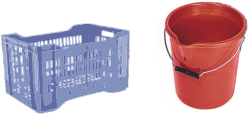 | |
THERMOPLASTICS 4 Polypropylene (PP) is a thermoplastic often formed into products through injection and blow moulding. It is robust, strong, flexible and supplied in a range of colours. Food containers, chairs, packaging and storage units. 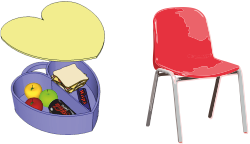 | THERMOPLASTICS 5 Polyvinyl Chloride. Better known as PVC. A tough material, purchased as either a hard (inflexible) material or alternatively a flexible form. It can be extruded, welded or bonded with an adhesive. Range of uses including water pipes, raincoats, long play records, coating on electrical wires and packaging. 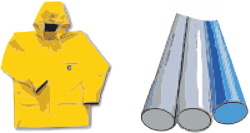 | |
THERMOPLASTICS 6 Nylon. Is used in engineering to make gears and bearings. It’s oily nature means that friction is reduced between moving parts made from nylon. Gears, bearings, wheels and clothing. 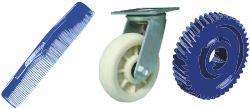 | THERMOPLASTICS 7 High Impact Polystyrene (HIPS). Light material and yet strong. Available in a range of colours. Can be vacuum formed. Thinner HIPS is quite flexible. Used for electrical casings, packaging, trays 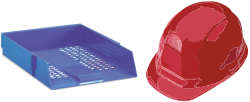 | |
FERROUS METALS - IRON Wrought Iron was used by the Romans. Roman iron weapons were forged, not cast. Iron was forged by heating it to high temperatures (to red heat) and hammering it into shape. Britain had numerous Roman iron ore mines. It also had large forests, which provided the wood required for smelting (extracting the iron form the ore). 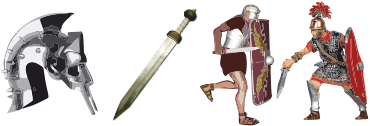 | FERROUS METALS - IRON - INDUSTRIAL REVOLOUTION Abraham Darby 1st (1678 –1717) Developed a technique of producing ‘pig iron’ in large quantities, through casting molten iron, crucial to the industrial revolution. He developed sand casting techniques, making it possible to produce cast products of a high standard. 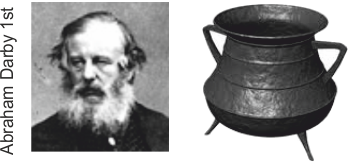 | |
FERROUS METALS PROPERTIES OF IRON Cast iron has a carbon content higher than 2.1%. Cast iron is brittle and can snap. Cast iron is likely to break/shatter if dropped or when it receives a ‘blow’. Products include; cast iron garden furniture, house numbers, weathervanes and vices. 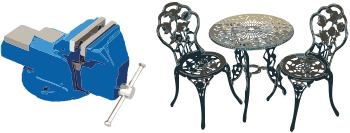 | METALS- WHAT IS AN ALLOY? An alloy is a metal (parent metal) combined with other substances (alloying agents), resulting in superior properties such as; strength, hardness, durability, ductility, tensile strength and toughness. The parent metal is the majority of the alloy. For example, mild steel is 0.1 - 0.3% Carbon and 99.9 - 99.7% Iron. 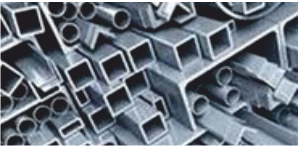 | |
FERROUS METALS THE ALLOY STEEL Iron is the most used metal in the world, largely due to it being the main constituent of the alloy steel. Common steel typically has 0.2 to 2.1% carbon content, with the rest being iron. Our modern world relies on steel  | FERROUS METALS - MILD STEEL Carbon 0.1 - 0.3% Iron 99.9 - 99.7% Alloy of carbon and iron. Tough. High tensile strength. Can be case hardened. Rusts very easily, unless the surface is protected from moisture. Most common metal used in school workshops. Used in general metal products and engineering. 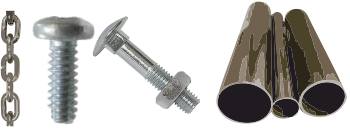 | |
FERROUS METALS CARBON STEEL Carbon 0.6 - 1.4% Iron 99.4 - 98.6% Alloy of iron and carbon. Higher carbon content than mild steel. Tough and strong. Carbon steel can be heat treated e.g. hardening and tempering. Used for cutting tools such as drills and lathe tools. 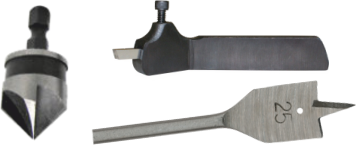 | FERROUS METALS STAINLESS STEEL Alloy of iron, nickel and 10.5% to 11% chromium. Tough, resistant to rust and stains. Does not corrode. Cutlery, medical instruments, specialist corrosion resistant products such as pipes. Stainless steel pots and bans. Jewellery and watches. 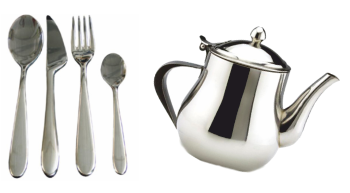 | |
FERROUS AND NON-FERROUS METALS Ferrous metals contain IRON These are metals that contain iron. Consequently they tend to rust / suffer from corrosion. They need protecting with paint, oil or a surface finish. They react to a magnet. Non-ferrous metals do not contain IRON Non-ferrous metals do not contain iron. Consequently, they do not to rust or suffer unduly from contact with moisture. They do not react to a magnet. | NON-FERROUS METALS ALUMINIUM Light grey in colour. Smelted from bauxite ore. Aluminium 95%, Copper 4%, Manganese 1% Ductile, soft, malleable, machines well on lathes and milling machines. Very light and resists corrosion. Can be cast into products from ingots. Used widely in aircraft, drinks cans, window frames, ladders, and kitchen ware.  | |
NON-FERROUS METALS COPPER Reddish brown in colour, darkens slowly when in contact with air. This metal is not an alloy. Ductile, can be beaten into shape as it is relatively soft. Conducts electricity and heat. Electrical wiring, tubing, kettles, bowls, pipes and plumbing. Used also in the production of printed circuit boards.  | NON-FERROUS METALS BRASS A copper alloy. Deep yellow to golden colour. An alloy, mixture of copper and zinc 65% - 35%. Casts and machines well. Surface tarnishes slowly on contact with air. Conducts electricity. Resists corrosion. Parts for electrical fittings, engineering, ornaments, musical instruments. 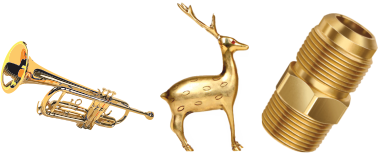 | |
NON-FERROUS METALS BRONZE A copper / tin alloy. Tin content up to 10%. Engineers well on lathes and works quite well with handtools. Once used for ship fittings, due to its resistance to corrosion. Now replaced by stainless steel. Used for ornaments, cast bronze sculptures and ships propellers. Used also for bearings in engineering. 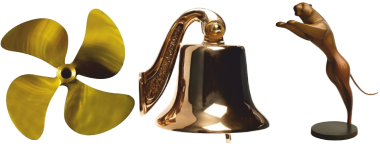 | NON-FERROUS METALS PEWTER Pewter is a soft, malleable alloy, 85% to 99% tin. Other metals are copper, lead, antimony and bismuth. Has a low melting point compared to many metals (170–230 °C) making it highly suitable for casting. Usually purchased in ingots and cast to shape in a workshop. Used for making tankards and other decorative pieces. 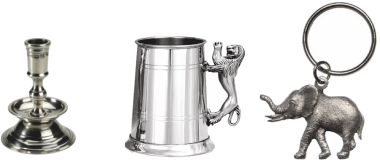 | |
| WHAT ARE COMPOSITE MATERIALS ? Composite materials, also called Composites. Composed of two or more materials, that have different properties. The materials are bonded together and their properties are combined. Composite materials combine the physical properties of the individual materials they are made up of, forming a superiormaterial. KEVLAR - REINFORCED CONCRETE PLYWOOD - GLASS REINFORCED FIBRE CARBON FIBRE | COMPOSITE MATERIALS - CONCRETE 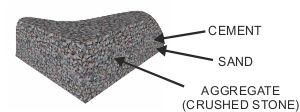 Used in construction, roads, brick laying, building and many more. Concrete is composed of a number of materials, that combine to form this versatile building material. Most concrete is made up of Portland Cement, aggregates (gravel, crushed stones) and sand. Water is added to the mix. | |||||||||||||||||||||||||||||||||||||||||||||||||||||||
| COMPOSITE MATERIALS - STEEL REINFORCED CONCRETE  Concrete is weak when put under tension. If reinforced with steel rods, it is can withstand tensile forces. Reinforced concrete has long steel rods passing through its length, adding great strength to the final composite material. Able to resist tensile forces. Used for bridge building, skyscrapers and general large scale construction. | COMPOSITE MATERIALS GLASS REINFORCED PLASTIC(GRP) Composed of strands of glass and woven to form a flexible fabric. Placed in a mould and polyester resin is added, followed by a catalyst (to speed up the reaction). Allowed to dry/cure. The resulting material is strong and light. Can be sanded and painted. Used for canoes, car bodies, small swimming pools, water tanks, surfboards, small boat hulls.  | |||||||||||||||||||||||||||||||||||||||||||||||||||||||
| COMPOSITE MATERIALS CARBON FIBRE REINFORCED POLYMER (CFRP) Carbon fibre is woven into a textile material. Epoxy resin is added and allowed to cure. The resulting material is very strong and light. An improvement on glass fibre reinforced plastic, although much more expensive. Uses; Aerospace, expensive sports cars, competition bicycles and motorbikes. 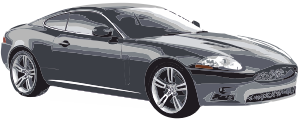 | COMPOSITE MATERIALS - KEVLAR Kevlar® is a liquid, converted into a fibre (called aramid fibres) and woven into a textile material. Extremely strong, lightweight, corrosion and heat resistant. Has a high tensile strength to weight ratio, far exceeding steel, carbon fibre and specialist alloys. Uses when combined with other materials: bullet proof jackets, armour for military vehicles and planes. Formula 1 fuel tanks. 
| |||||||||||||||||||||||||||||||||||||||||||||||||||||||
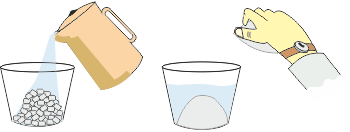
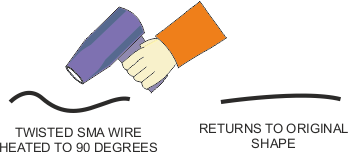
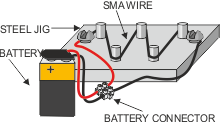

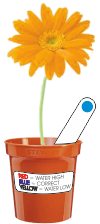
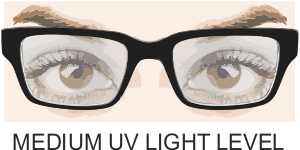
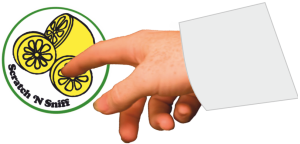
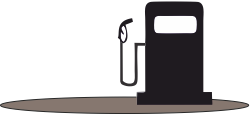
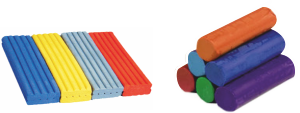
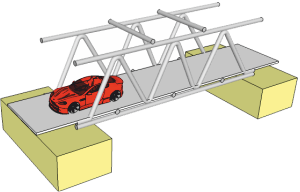

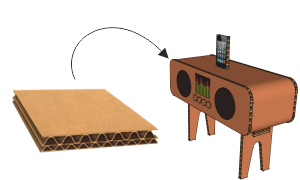


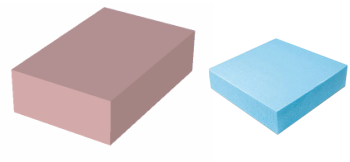
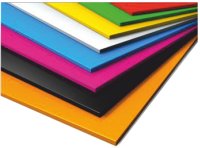
No comments:
Post a Comment